01 Jan FTTH installation Technologies
FTTH installation technologies
Table of Contents
- Innovative approach to FTTH installation Technologies…1
- Infrastructure Sharing…2
- Duct sharing in France…2.1
- Sewer pipes…2.2
- Clean water pipes…2.3
- Gas pipes for Houses…2.4
- Creative FTTH installation Technologies Installation Methods…3
- Handheld fiber cable blowing machine …3.1
- Pushable fiber …3.2
- Fiber optic cable de-coring …3.3
- Creative FTTH Components …4
- Flat micro-duct systems …4.1
- Micro-Ducts …4.2
- No epoxy, no polish connectors …4.3
- Pre-terminated fiber optic cable…4.4
- Creative Project Design …5
- Case Study: Parham, United Kingdom …5.1
- Avoiding highways and associated costs …5.2
- Design for customer self-connection …5.3
- Cost breakdown of the Parham FTTH Project …5.4
- Conclusion
Innovative approach to FTTH installation Technologies 1
Innovative approach to FTTH installation Technologies and a case study in the UK. The rates of investment in the European access networks to fibers, particularly in Asia Pacific, the Middle East and North America, have been slightly slower. In countries that usually have high costs for developing new networks the business plan can be especially difficult to bring together. There is no question of whether a fiber is the right option in the local network – everybody knows it’s the perfect technical solution. The discussion is now over creating a network not too expensive to deploy or run. Depending on the region covered, the expenditure needed may differ considerably.
Owing to the long distances to residences, diminished rural areas are the most costly to communicate with. There are denser communities in urban areas. However they also create development difficulties, especially where existing canal infrastructure has limited space.
Regardless of the area, building is the most costly part of the project (or civil works, as they are sometimes referred to). Some figures put it up to 80% of the total expense. Building thus presents the largest potential for reducing network construction costs.
In the early years of the business venture, the cost of building is loaded.
Reducing building costs would improve the business case for developers, thus rising the rate of FTTH installation Technologies.
In this article, creative approaches and equipment can be considered to minimize FTTH installation Technologies costs. The term “innovative” recommends alternative approaches, which only the few utilize. The processes, equipment and goods mentioned in this document are not yet commonly used – but they may evolve over time.
Options to standard trenching strategies have arisen over the past few years.
Any of them have been easily recognized as part of the repertoire of “standard” tactics such as micro-trenching and lateral perforation.
The alternative building strategy and equipment illustrated in this paper will minimize optical distribution network building costs (i.e. the part of the network outside the home or building). In each case, we will clarify and describe the benefits and disadvantages of the procedure or apparatus.
The most noticeable way for civil work to be minimized is the use of current buried infrastructures such as the incumbent operator’s pipeline network.
In fact, duct sharing is less than one might expect and in many countries its implementation is very recent. We look at the French case and see if the separation of ducts was allowed.
Multiple utilities, such as drainage, gas or water pipelines, also offers openings in the feather portion of the network and in the final decline in the building. Infrastructure sharing is possible. Coaxial cables are also reused as an optical fiber duct. There is a way.
The pace and ease of assembling also influence the costs of the plant. New devices have been designed to allow fiber optic cables to be mounted in ducts with fewer engineers faster. Innovative modules allow for fast assembly, but without advanced equipment, of ducts, branches and linking structures.
Finally, we are looking at a rural initiative that has incorporated a variety of new concepts. Instead of preferring to trench in farmers’ fields, this included the avoidance of road building entirely and the self-connection to the client from a frontier box to the house itself.
A lot of revolutionary approaches and installations will exist, but this won’t be detailed. For a more comprehensive overview of FTTH installation Technologies, see the FTTH Handbook, which is also provided by the Implementation and Working Committee of the FTTH Council Europe.
Although fiber building costs are just one aspect of the business case, they are significant. Reducing running costs in Europe will dramatically increase FTTH implementation.
Infrastructure Sharing at FTTH installation Technologies 2
Pipe/Duct sharing in France 2.1
A simple solution is to reduce the expense of FTTH networks by sharing the duct and pole facilities of the existing telecommunication provider.
The governing body in France established rules for the sharing of the ducts and in 2008 the access procedure was approved. Since then, Open, SFR and Numericable, the big alternative operators also abandoned all civil work in order to build their own duct infrastructure and begun to mount their cables in the conduits of Orange, operator at the time (France Telecom).
The cabling from multiple operators on the same conduit has to be removed physically (that needs subducting), and the operator who deploys an optical fiber cable has to ensure that there is enough space left in the same duct section so that its candidate can mount the same-sized optical fiber cable in the same section.
Since many operators now use a duct system initially built for a single operator, the existing duct space needs to be used as effectively as possible. The fee for Orange’s rental canal room is specifically proportional to the cross-section of the installed fiber optic cable. This helps alternate operators to use fewer room-saving smaller cables.
Flexible textile sub-ducts can be used in duct parts with limited space. Flexible textile internal canals take up three times less volume than rigid internal canals, which maximizes cable installation. Flexible internal ducts may also be used where rigid ducts are usually used but failed to install as the duct has been partly crushed or filled with soil.

Figure 1: Flexible inner ducts maximize the use of duct space.
In the photo above, there is a 100mm inner tube with three rigid subconduits that carry 3 wires but have a lot of space lost. With the use of interchangeable inner conduits, extra cables from three alternate operators may be connected to this still cramped conduit, in this situation three. This vent will be complete without flexible inner ducts.
It is estimated that nearly EUR 2.5 billion have been saved over five years by removing civil work on new cables in France, with comparable savings possible in the next five years. ROI of FTTH ventures can be significantly enhanced by the massive savings from the duct sharing. Developments that might not have been feasible have been introduced in certain instances.
While it is possible to share ducts in most European countries however, like in France, millions of savings may be made, the solution is not commonly adopted. The main factors contributing to general recognition and implementation of the sharing of infrastructure in France were the
The strong vision of the French Government concerning high-speed broadband networks and ARCEP as an empowered, independent telecommunications regulator facilitating the whole project and tracking viability and the Agreement’s financial and technological consistency.
FTTH installation Technologies
Sewer pipes 2.2
Wastewater tanks are nearly omnipresent. Almost 99% of the people of the Netherlands were concerned with municipal wastewater treatment. More than 90 percent of their population has been related to waste water treatment in other European countries such as Austria, Germany, Spain and Great Britain. It is possible to meet more people via the current sewage grid in order to install fiber optic cables. Sewers are often deeply buried on the ground which makes them less vulnerable to adverse events.
This is not entirely modern: robotics were initially assisted by cables mounted on Tokyo wastewater treatment systems in 1987. The concept is very new. Municipalities today are more and more involved in managing remote areas of wastewater management systems and see some benefit from installing fiber optic ropes in their sewage systems. Furthermore, errors can be observed and mapped in the drainage system during building.
Naturally, there are drawbacks. The plant must be built not to interfere with the flow of polluted water and should be harmful gas resistant to the materials for the construction. Common sewage filtering techniques must also be avoided by the system. The cable blowing machinery of the fiber optic cable which have to pass angles and joints in the sewage lines.
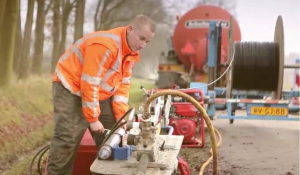
Figure 2: The fiber optic cable is blown into the sewer system on water pressure (10 bar) or pneumatic (12 bar) – FTTH installation Technologies.
Clean water pipes – FTTH installation Technologies 2.3
It is therefore not a new concept to install cabling in the domestic water system. In their drinking and waste water pipelines water utilities have also inserted sensors and data cables into networks for their own use. But without ads – they did so to prevent public opposition. With the advance of FTTH, the optical distribution network is being requested for new subterranean routes.
Two tools for the construction of fiber optic cables in household water pipes have been built in Europe during the last few years. This networks have inexpensive and eco-friendly methods of running fiber optic cables across current water pipes. Both solutions require the installation of separate adapters in the water supply pipe at start/end access points. Then the micro-drive is mounted between the two fittings, providing an area that is gas-tight and in which fibers can be threaded without direct contact with water.
The first method involves the drilling of two small pits, one at the foot or road demarcation and one at the wall. Delete and restore small parts of the pipe with new branches in the ‘Y’ shape. The fittings of the branch use regular sprinklers, meaning that they are easily mounted without specialized equipment. An external diameter microduct is then placed here between two fittings of the section, supplying a gas resistant route within which fiber optic cables can either immediately or at a future date be blown.

Figure 3: Fiber optic cable diagram for water pipes – FTTH installation Technologies
The business sells still another device that can be put in the higher pressure and wider delivery mains with a micro-conduct diameter. This variant can be used to supply high fiber count cable trunk delivery routes (144 fibers or more).
The second solution is aimed at fiber links to several buildings. This procedure involves only the excavation of a single entry channel. The 7 m wide conduit is flowed through the residential water pipe from the entry point, which is usually situated in the basement or the service link room of the building before you enter the road access hole. Electrofusion welding is used to insert joints into the tubing. Without any further drilling individual fiber optic cables are then fed directly further into cave via the road duct.
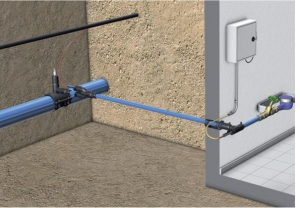
FTTH installation Technologies – The duct containing the fiber optic cable
Figure 4: The duct containing the fiber optic cable enters the building inside the drinking water pipe – FTTH installation Technologies.

Figure 5: Drinking water pipe connection, in an installation in Adenau, Germany – FTTH installation Technologies
Both solutions can significantly reduce installation costs, by minimizing the need to excavate and reducing the time taken to install the fiber optic cable. Another benefit is the minimal impact on the established ground surfaces and entry points to the existing property.
The systems have been designed to not to have any appreciable impact on the hydraulic performance of the water pipe and no “stagnation zones” (areas of poor flow). Components that come into contact with drinking water must also comply with local water regulations.
Gas pipes for houses – FTTH installation Technologies 2.4
The residential gas supply link would be another potential network. For eg, in Germany, roughly 60% of all establishments are natural gas fuelled.
Similarly to those of drinking water tubing, a vent may be inserted into the attachment channel. Fiber cables can be moved mechanically or carried under compressed air through the tube, depending on the necessary power. This can be achieved at any period after completion of the pipe. The vent interfaces and fibre-optic conducting and leading out/in contacts are securely and securely incorporated in the gas pipe by using electrofusion welded fittings.
In comparison to the drinking water option, this method often needs two entry holes so locally controlled adapters in the gas pipe should be outside the house. Afterwards, a new hole in the wall would be placed in the house.
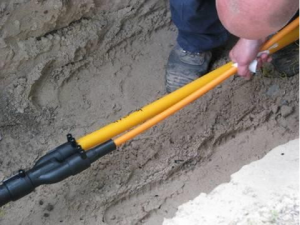 | 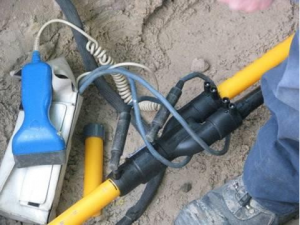 |
| Section 6: The duct d16 x 3.0 mm is inserted via the section through the gas service tubing. | Section 7: The pipe generates a uniform, gas tight link in the pipe. |
The design specs of national gas supply legislation and policies shall be consistent and accredited accordingly for each part, tubing, fixtures, junction boxes and adapter. The products must be gas-resistant and their admixtures to be used primarily in the gas industry.
The supply impediments created by the narrower cross-section of the main conduit are usually insignificant. To check feasibility, the pressure drop and the flow can be measured.
FTTH installation Technologies – Installation Methods 3
Handheld fiber cable blowing machine 3.1
Installation of cables through pipes or ducts utilizing dragging, pressing and blowing methods is the standard form of cables in organized networks. Builders must not reach the maximum allowable cable pressure when pulling or exceed the minimum radius for bending when pressing or blowing, either with extreme care and ability. The fiber optic cable will easily be destroyed during construction if due caution is not taken, that would cause fiber loss. The harm will not necessarily be apparent and may allow the lifetime of the fiber optic cable later to fail.
Cables had high levels of fiber and were heavily armored in the early years of fiber installation in network backbones and especially on long range lines. The installation of these large hard cables, providing a considerable pushing power during compressed air lubrication, is essential for heavy duty equipment. Though in circumstances involving less qualified technicians and longer fiber optics cables more humans can be needed, such devices usually need minimum 3 persons to work.
 Fiber optic cable blowing machine; turkey, made in turkey | |
Section 8: Example of fiber optic cable blowing machine. – FTTH installation Technologies
For the construction on increasingly busy canals and sub-conduits, FTTH has identified a preference for narrower, high-faser-count cables. More cable, but also over less arduous lengths, must be mounted by the operator. Consequently, installation equipment is not mandatory because the push forces and air demand are much smaller. However, trained operators are also required and it can be claimed that the use of cables with smaller sizes needs greater caution than large cables without harm.
Recently, new cable blowing machines were introduced on the market to cope cost-effectively with these specifications. Cable Blowing Machines that can offer long distances that push up to 1 kilometer, are more frequent at great velocity and have limited chance of fiber damage. Supervising, hand-held, hand-operated, telecaster, underground chambers and houses, lightweight machines will assist to keep costs and risks to their limits, and technicians will be able to set up as much fiber cable as possible in any given time.
Figure 9: Handheld fiber optic cable blowing equipment – FTTH installation Technologies
Pushable fiber 3.2
In the last 20 years, blown fiber has been reached. New versions, pushable fiber, of this technology make it much easier to use and accommodate new and current worlds in higher expense.
In its most direct form, robust micro ducts drive pushable fiber assemblies to convey fiber to the appropriate endpoint. When used on a single-ended assembly with a pushable connector, half the work is omitted. If a pushable connector is used on one end and a normal industry connector on the other, all splicing and end works can be removed. The savings in labor costs will easily improve with professional splicing labor in excess of €55 per hour.
Pushable fiber paths are either formed or buried in air or in new or existing pipelines that are frequently otherwise regarded as spent (no room left for traditional conduits or fiber optic cable). The path can be moved from an external plant (air or buried) to an internal plant environment with a clear, airtight and waterproof connector requiring minimal installation of tools that permits one continuous line from A to B.
Furthermore, it must not be forgotten the restore capability for “cut” or “severed” fibers. In case of a cleaning fiber, you can position and drag the pushable fiber out of the conduit, and this acts as a measuring tape to quantify a simple distance for a substitute commodity. At that point, the roughly robust micro-duct is accessible and easily repaired with airtight and watertight connectors to complete the course. The substitution machine is retracted – often without a splicer rolling and others with unqualified work.
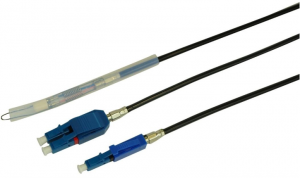
Section 10: Examples of pushable fiber optic assemblies – FTTH installation Technologies
Fiber optic cable de-coring 3.3
The internal heart of underground copper phones, coaxial or electrical fiber cables can be removed without excavation by a patented technique. Obvious solutions have been developed. This leaves an open pipe primed for replacement of fibre.
The path would only be reached at 2 places rather than drilling the whole fiber optic network, which cuts costs and length of the job considerably. It was effectively decoded paths of up to 1500 feet (450 m).
The proprietary method requires the current installed optical fiber cable to be separated from the heart and the exterior sheathing left in the ground. This is accomplished by pumping a specifically formulated liquid into the fiber optic cable at high pressure. The liquid grain splits the chemical bonds between the outer jacket and the inner center of the fiber optic wire. As the fluid is pulled out from the other end of the fiber cable, a copper core is removed by means of a winch and is reused afterwards.
The system was employed in many European initiatives but has been tested internationally in other nations.
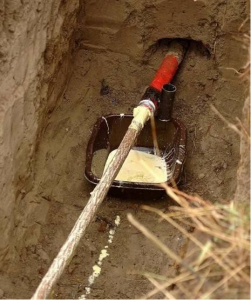
Section 11: Fiber optic cable de-coring in progress- FTTH installation Technologies
Creative FTTH Components 4
Flat micro-duct systems 4.1
Micro-ducts are narrow conduits, common for installation of fiber optic cables between a diameter of 7 and 20 mm. They may either be used as single pipes or clustered as round or flat in a sheet to tie the package together.
Thin-walled micro pipelines provide no security and are equipped for use in existing pipeline systems. Thick-walled micro-leavings have a 2mm diameter of wall, which protects them from crush, distortion and corrosion and are suited to direct burial (subject to proper construction – dust bundles of ducts should be covered before re-filling and compression).
The sheath does not require protection for dense wall designs, it has the objective to repair the micro-ducts in the package and to hold an identifying color or stripe.
The recently designed flat micro duct packets. The flat configuration is twist resistant and can be placed smoother.
Figure 12: Single thick-walled micro-ducts |
Figure 13: Micro-duct bundles in a round design |
Another bonus of operating with flat micro-duct structures is that they require no extra soil protection, so there is no need for additional housing or closes. Instead, a slot may easily be cut into the sheath to reach individual micro-leads. A branch is created using an effective push-fit connector by pairing one tube with another. This “slot cutting” and “branching off” method is fast and simple, vital as accessing multiple places and linking homes is required. The quick method leads to lowering prices..
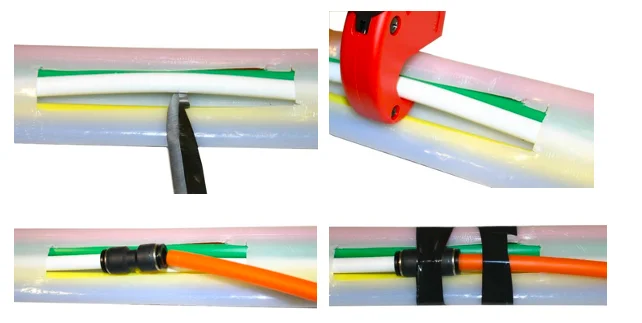
a branch in a flat micro-duct system – FTTH installation Technologies
Figure 16: Creating a branch in a flat micro-duct system – FTTH installation Technologies
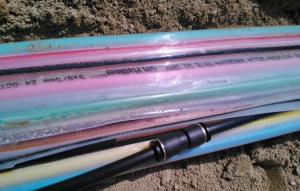 Flat micro-duct bundles in the ground – FTTH installation Technologies |
Figure 17: Flat micro-duct bundles in the ground – FTTH installation Technologies
MicroDucts 4.2
This is a brief description about Micro-ducts which is actually another topic to describe. In polyethylene sub-ducts also called inner-ducts, in nominal diameters of 25-51 mm, full-size underground fibre-cables have historically been installed. Inner ducts can be used in traditional PVC, asphalt, clay tile or bituminous fiber indoor 75-100 mm diameter. In a 100 mm main conduit, normally 3 to 4 internal pipelines can be mounted. In any inner behavior there is normally one regular telecommunications size optical cable. The telecommunications conduit structure can be split into several small and protected places for the smaller “micro-duct” fiber cables to position with the use of smaller diameter micro-ducts matched to small diameter micro-producing cables. These micro-conductions can already be mounted in the external plant in inducts, sub-conductions, or in bigger telecommunications conduits. A similar multi-unit product is developed by the plant installing micro-ducts into new inducts, and instead, micro-ducts are mounted into larger casings which can be put in or directly buried in the subterranean duct system by multiple micro-ducts into a versatile over-cased unit. These microscopic items allow the fiber cable to be mounted to satisfy current service specifications and the space for replacement ducts to be used in the future to support new cables as such demands occur.
No epoxy, no polish connectors 4.3
In reality, fusion-spoilt (fiber to fiber or fiber to pigtail), physical splicing or joining with an epoxy and polish connector have been the basis of three major techniques until currently for the completion of optical fiber. Every approach has advantages and inconveniences:
| Parameter | Fiber-fiber splice | Fiber-pigtail splice | Mechanical splice | Epoxy and polish |
| Performance | < 0.2 dB | < 0.5 dB | < 0.5 dB | < 0.5 dB |
| Skill level | High | High | Low | Medium |
| Time to joint | 2 mins | 2 mins | 4 mins | > 5 mins |
| Capital Investment | High | High | Low | Medium |
| Reliability | High | High | Medium | Medium |
| Product cost | Low | High | Medium | Low |
| Environmental resistance | High | High | Medium | Medium |
Ideally, installers are aiming for the best of both worlds: high reliability low-loss link, but still easy to assemble. This is feasible with the latest introduction of field-fit non-epoxy and non-polished (NE/NP) connectors. These connectors have an installed loss of more than 0.5 dB and around two minutes. They need limited tools, and investment in capital will provide a potentially highly durable ecologically friendly connector. Indeed, the work has been done in the plant for the installer that eventually results in a multiple standard connector being the unit costs for these items.
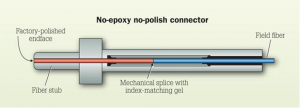 No-epoxy, no polish connector – FTTH installation Technologies |
Figure 18: No-epoxy, no polish connector – FTTH installation Technologies
The successful Return Los (RL) of the connector typically requires passive optical networks (PONs). Normally, RL is not a field-measurable parameter and typically needs only factory-funded special measurement tools. Thus pigtails ensure optimal RL, but marginal efficiency
Using fusion splicing devices related prices. Epoxy and polished or electronic splice can be difficult to measure RL. With little upstream investment, the above NE/NP connector will provide exceptional RL.
The design of NE/NP connectors indicates it is not likely that the field fiber retention on the back of the device is as high as a regular pigtail connector. Unique product configurations must be tested if this parameter is significant.
Pre-terminated fiber optic cable 4.4
When installation times are incredibly tight and the installer capacities available are high, pre-connected cables can be installed. These devices will have a qualified output from end-to-end connector to end-to-end connector.
Today the industry has three types of pre-finished cables: I long-distance, high fiber material, multiple connector products, (ii) single- or double SC fiber, and (iii) pre-connected blown fiber.
In FTTH setting, high-count multi-connector cables are not popular. Typically, the goods include a fiber optical cable at each end to retain and protect connectors (connectors may be reinforced environmentally) and an eye to pull.
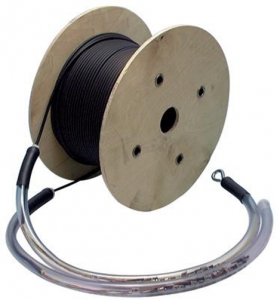 | |
Figure 19: High count multi-connector fiber optic cable – FTTH installation Technologies
In FTTH installs, low numbers and final drop cables are typical. The cables may be at end-of-stage or end-of-stage. Terminated single-end cables are typically broken into the field node and plug-in into the client end. Double-end cables include a field node which has a patch field connector:
Pre-ferrous fiber optic cable devices have been added to facilitate the installation of 2- or 3-mm cables within micro-lines, with connector housing placed after the fiber optical cable is separated from the micro-lane. This makes the micro pipes with 6mm or less to give the mounted component a much more cosmetically friendly look.

Figure 20: examples of pre-ferruled fiber optic cable products- FTTH installation Technologies
The use of pre-finished cables includes meticulous preparation and planning of stocks. When the user is wired from the last node, caution must be taken to prevent leaving a significant volume of fiber optic cable at the building’s entrance. Minimum slack fiber optic cable can be stored but commodity at intervals of 10 to 20 m even under this provision is required in a broad array of inventory length.
The final form of product which is typically pre-finished is blown fibre. The smallest and lightest fiber items are blown fibre cables or fiber units more accurately. They are configured just for installation in their micro ducts. Fiber units typically have an exterior diameter of between 1.0 and 2.0 mm, and contain between 1 and 12 fiber optic.
The lead of a blown fiber unit is usually not suitable because the unit is not durable enough to handle the extra load put on the plug. In that case it is typically attached close to the rim, while the front end is ready to be fused or connected to a field-fit product. This also suggests that a hit from the customer’s point back to the node has to take place. If the tracks consist of a duct or micro duct, their installation address, the appropriate installation output and type and number of connectors needed, the choice between options will depend on the design and duration of the path.
Creative Project Design – FTTH installation Technologies 5
In just the same work many new installation methods and tools can be used at the same time to reduce costs. For rural areas, where overall cost of installation is likely to be higher, but the prospects for improvement are hopefully greater, new methods are especially relevant. A real life representation of innovating design concept is determined by the following given scenario.
Case Study: Parham, United Kingdom 5.1
Parham is a broken town in a remote broadband region called not location in Suffolk, UK. Rural areas like this mostly have no new networks, such as ducts and sub-ducts, sometimes have far larger gaps between premises with privileges to transport not even the fastest path and lesser clients to connect. There is little need for travel. Throughout this specific situation, there have been up to 80 buildings, which occupy nearly 4 kilometers in three geographically different regions. Connecting this population to broadband will be incredibly difficult.
An appeal for the architecture, implementation and service in Parham of the FTTH network was provided by a public sector agency in 2012. NGA Connect Ltd., the local construction firm, replied the tender by way of an approach and product kit that will make the facility simpler and cost reduction to address the challenges of this very rural fiber facility.
The scheme had a limited budget of £150,000 for the design, structural engineering, building and consumables, primarily from public funds. It was evident from the start that the minimal resources available was that regular installation and installation configurations would not be possible.
The suggested approach adopted the “tractor broadband” concept, which will use the property owners’ permission field limits to avoid costly civil engineering road expenses in the case of Broadband for the Rural North (B4RN) initiatives, which were applied in Cumbria, United Kingdom.
This system is yet flexible to more network roll-outs in terms of equipment and implementation developments. In fact, in order to minimize costs, a system was created whereby the customer is immediately connected to the network in collaboration, since the most expensive aspect of the implementation has been splicing and repair to consumers. We created a solution in which we could operate uniform boxes on the limits of client premises then they’d be responsible for laying micro ducts as part of a package in their fields and land, either entirely connected by the client, or with the help of a specified village specialist.
Avoiding highways and associated costs 5.2
The Highway Agency’s high charges prohibited fiber from being traveled by roads and edges. While the roads (it is unusual for rural property that cannot be linked to the road) are commendable, they may not have made use of the alternative of installation by a fee of £61/m (80Euro) for roads and £10/m (12 Euro) for boundaries until costs of structural engineering and traffic control..
Land frontiers – typical in most country places, defined as the main way to minimize the cost of building rural fibres. The terrain on the side of the field remains largely unchanged and the highway department does not order a monthly reservation. Huge structural infrastructure machinery can be accessed to the property without any roads being blocked, would be costly and would cause severe disruptions to residents.
The cooperation of local landowners is definitely the cornerstone to this strategy, and any impact the trenches may have must be taken into account. Field limits at the tops of the fields are the safest spot, since they impact less the runoff of the landowner.
The majority of Parham properties are surrounded by field borders and the village has been described as the cheapest and least destructive alternative, which is the rear end of the properties along the fields.

Figure 21: The route follows field boundaries at the rear of properties – FTTH installation Technologies
The fiber cable route connected to a position in a service building in Framlingham, a remote, nearby town. This site has been selected as the backhaull fiber networks and power supplies provided by the generator have been reached, helping also minimize costs.
In order to reduce road crossings and the related expense, Parham was deliberately selected. The disused rail line was part of the road. Road crossings were meant to be handled with horizontal or lateral boring.
Ducting and fiber can be laid with trenches and mini-figurators, as the path is feasible, employing local contractors and, if applicable, a specialist in rural drainage who has considerable experience in the laying of telecommunications tubing in the area of local farmers..

Figure 22: The route follows a disused railway line as it enters Parham UK – FTTH installation Technologies
Design for customer self-connection 5.3
Unless 100% of houses paid for a service before the network was completed, installers will traditionally have to return to the site if they added customers. The best approach was to leave a “self-connect box” for the customer at the edge of each house. This minimizes the risk of moving the house, as no maintenance on consumer land is completed.
The border point between the user and the network is the link point. It is composed of an IP68-rated standard box with communication ports particularly designed in the auto-install pack for the connectors supplied. Here the consumer can connect with a split-less plug-n-play adapter. This box is in an IP65 container and is partially inserted in order to open the box. Both consumer premises passed are placed at the border of their boxes.
Key point 2: Install “plant pots” at the boundary of every passed property.
In terms of price per meter, the final section of consumer connection was defined as the costliest. The approach would be to enable the consumer to do this himself. The method must be sufficient for the consumer to use without preparation, to secure the delicate fiber and toughened in its construction.
Key Point 3: Provide a pack of products that enable customer to connect themselves to the network when they are ready by providing “Customer Install Packs”.
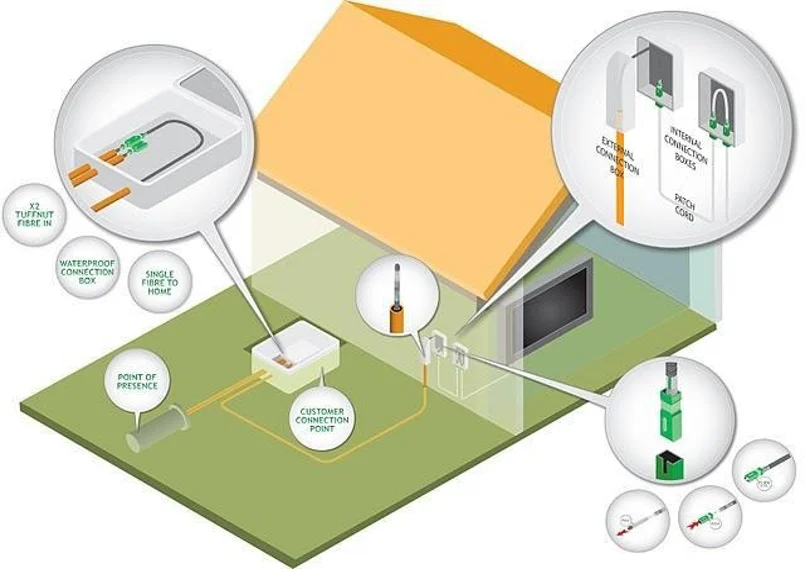
Details of the customer self installation.
Figure 23: Details of the customer self installation. FTTH installation Technologies
At the time of the connection order, the self-install pack will be sold to the consumer. This allowed for optimizing the network reach and the user knew what the access fee pays for. The pack helps the consumer to attach easily by plug-in of a regular connector to the network in the border package.
| Customer Install Pack (paid by customer): £250.00 – 282 Euro – ex VAT |
| 1x 150ft Black Corrugated UV Stable duct |
| 1x 150ft QuikPush fiber optic cable (SC Terminated) |
| 1x Waterproof Connector |
| 1x Instruction Booklet |
| 1x SC clip-on connector |
| 1x ONT (Fiber Media Converter, Telephone Capable) |
| 1x Outdoor Wall Box |
| 1x Indoor Wall Box |
| 1x Patch Lead |
Cost breakdown of the Parham FTTH Project 5.4
For the stated strategy, network construction costs is approximately 50 percent less than the expected cost of £300,000 based on conventional installation methods. The product specifications of the project plan are shown below. These data were exchanged by project managers to demonstrate that considerable cost savings can be accomplished by using non-standard technologies in the rural environment.
| Main Delivery Equipment: £29,990 – 33800 Euro |
| 1 x Rack 36u with Power Distribution Unit |
| 1 x Uninterruptable Power Supply |
| 9 x 48 Port SC Optical Fiber Patch Panels (with Pigtails) |
| 1 x Cisco Catalyst Switch with line cards |
| 2 x Network Monitoring Computer |
| 4 x 1000 Base -T SFP Pluggable Transceivers |
| 3 x 1000 Base – Lx SFP Pluggable Optics |
| 1 x Secure Rack |
| 1 x OLT Chassis |
| 1 x Set of Batteries and a rectifier |
| 3 x (1 X 32) Fiber Splitters |
| 1 x Uplink Card 4 x 1GB Ethernet |
| 1 x GPON Line Card |
| 1 x Active Line Card 20 Port of up to 1GB |
| 3 x GPON SFP |
| 5 x Active SFP’s |
| 100 x 1m Patch Leads |
| Fiber optic cable, Micro-duct and Closure Equipment: £24,000 – 27.000 EURO |
| 1x 8km of 12×8 Pre-fiberd 96 core Tuff duct |
| 25x 8 Connection IP68 Dome closure SNACs |
| 12x 16 Connection IP68 Dome closure SNACs |
| 164x 100ft Tuffduct 8×6 |
| 164x 100ft Quik Push Fiber optic cable with SC Connector |
| Other Delivery Equipment & Costs: £28,930 -32600 EURO |
| 82x “Plant Pot” – Customer Delivery Connection |
| 1x Splice Machine |
| 8x Handholes |
| 3x Splice Closures |
| Maps |
| Backhaul Installation Cost |
| Labor and Civil Engineering: £78,052 – EURO 87.900 |
| 13x 1 Day professional splice engineer |
| Civil engineering including trenching, fiber optic cable laying, back- filling, road crossings, permissions and traffic management. |
Total install cost for 80 residents: £160,972 – 181.400 EURO
Abstract
For inexpensive and effective rural bandwidth connections, the Parham prototype is:
- To minimize licensing fees, use land boundaries instead of highways and borders.
- Use the layers and fibers of local civil engineers and field contractors, using the kit kit tailored for direct handling.
- Minimum splicing strategy to minimize splice work significantly, and only at crucial stages.
- Stop blowing fiber since it is wasteful and inconvenience; use fiber prefabricating for key routes and fiber push/pull for declines.
- Consumer connection plan for a particular merchandise kit. • Customer connection plan..
Conclusion
In the last few years already, investment criteria for FTTH have drastically fallen. The sector and its supply chain are definitely helping to expand in sophistication. Increased purchase rates help lower premiums and overhead costs across a wider consumer base may be distributed.
The use of productivity enhancement by service providers by enhanced processes, advanced instruments and materials, and the use of labor-saving approaches have been a significant contributor to reducing the FTTH expenditure requirements.
There is still potential for creativity, particularly in rural areas, to further reduce the costs of FTTH installation. Standardized approaches and products for network backbones are created, which many subscribers share as well as urban environments where there are short distances between subscribers. To penetrate and link neighborhoods in remote areas, new approaches would be required to reduce the “cost per meter” of fiber optic cable construction.
The creative solutions mentioned in this paper are designed to minimize costs per meter through disqualification, robustness, simplification and the use of the right rural resources.
New Approaches:
All FTTH costs cannot be overcome by a single breakthrough. In fact, in any particular case not all of the new approaches mentioned here might be suitable or appropriate. For one, it needs agreement from utility providers to mount cables in water or gas pipelines, and this is not necessarily a matter of fact.
It is critical, however, that all projects seek alternatives to traditional installation methods. The FTTH business case can be strengthened by reducing the installation cost to speed up FTTH deployment in Europe.
Advancements in Fiber Optic Technology: Improving Bandwidth and Transmission Rates
Fiber optic technology has revolutionized the way we communicate, providing faster and more reliable data transmission over long distances. The use of fiber optic cables has become increasingly popular in recent years, and the technology continues to evolve at a rapid pace. In this article,......
03 March, 2024 No commentThe Benefits and Advantages of Fiber Optic Cables for High-Speed Data Transmission
Introduction In today’s fast-paced world, the need for high-speed data transmission has become increasingly important. From telecommunication companies to data centers and even homes, everyone requires reliable and fast data transmission. This is where fiber optic cables come in as the preferred method of transmitting......
03 March, 2024 No commentTight-Buffered and Loose-Tube Cables
The difference between tight-buffered and loose-tube fiber optic cables is in the way the fibers are protected and packaged within the cable. Tight-buffered fiber optic cables feature fibers that are surrounded by a tight-fitting buffer material, such as a plastic coating, to protect them from......
25 January, 2023 No commentOS1 and OS2 Fiber Optic Cores
OS1 OS2 Fiber Cores are types of single mode fiber optic cables that are used for high-speed data transmission. OS1, or “single-mode,” cable has a small core (typically 9 microns in diameter) that allows for a single light beam to be transmitted over long distances......
25 January, 2023 No commentFiber to the home (FTTH)
Fiber to the home (FTTH) is a technology that uses optical fibers to deliver high-speed internet and other communication services directly to individual homes or buildings. The fibers are run from a central location, such as a telephone exchange or data center, to a termination......
24 January, 2023 No commentBest Fiber Optic Cabling Installation Practices Guide
Fiber optic cabling installation is a complex process that requires specialized knowledge and equipment. Here are some best practices for fiber optic cabling installation to ensure a successful and reliable installation: Plan the Installation: Before starting the installation, it is important to plan......
23 January, 2023 No commentHow Fiber Optic Cables and Internet Affect Our Lives
Fiber optic cables use light to transmit data, rather than electricity. The cable is made up of a central core of extremely pure glass or plastic, surrounded by layers of protective material. Data is encoded as pulses of light that travel along the core of......
23 January, 2023 No commentCable Blowing Lubricant
Cable blowing lubricants are specially formulated lubricants used to lubricate cables as they are being pulled through conduits or other tight spaces during the installation process. The lubricant is applied to the cables before they are pulled, and it helps to reduce friction and make......
22 January, 2023 No commentAll about fiber optics
What does a fiber optic cable do? A fiber optic cable is a type of cable that uses glass or plastic threads to transmit data. These threads, or fibers, are extremely thin and are surrounded by a protective coating. They are able to transmit data......
22 January, 2023 No comment7 important points to blow fiber optic cable far away
7 important points to blow fiber optic cable far away, let’s take a look in deep on important cable blowing tips. Cable blowing is the process of blowing the cables into telecom ducts with the help of pressurized air. When using a cable blowing machine......
15 December, 2021 No comment




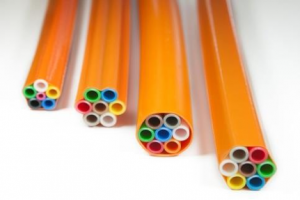
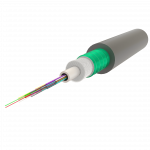






Sorry, the comment form is closed at this time.